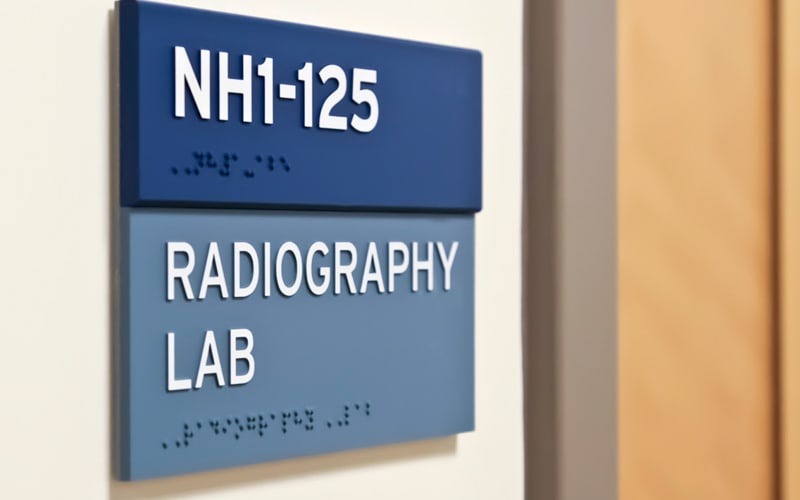The Function of ADA Signs in Following Availability Standards
Wiki Article
Exploring the Key Attributes of ADA Signs for Enhanced Availability
In the realm of accessibility, ADA indicators serve as silent yet effective allies, ensuring that rooms are accessible and inclusive for people with impairments. By incorporating Braille and responsive elements, these indications damage barriers for the visually impaired, while high-contrast color plans and legible typefaces cater to diverse visual needs.Value of ADA Conformity
Making sure conformity with the Americans with Disabilities Act (ADA) is essential for promoting inclusivity and equivalent access in public areas and offices. The ADA, enacted in 1990, mandates that all public centers, companies, and transportation solutions fit individuals with impairments, guaranteeing they enjoy the very same civil liberties and chances as others. Compliance with ADA requirements not only fulfills lawful commitments yet additionally enhances an organization's online reputation by demonstrating its commitment to diversity and inclusivity.One of the key facets of ADA conformity is the execution of available signage. ADA signs are developed to make certain that individuals with disabilities can easily browse via spaces and buildings.
Additionally, sticking to ADA policies can minimize the risk of lawful repercussions and potential fines. Organizations that fall short to comply with ADA standards may encounter lawsuits or fines, which can be both monetarily troublesome and harmful to their public picture. Therefore, ADA compliance is essential to fostering an equitable atmosphere for every person.
Braille and Tactile Components
The incorporation of Braille and tactile components into ADA signage personifies the principles of ease of access and inclusivity. These functions are crucial for individuals that are visually damaged or blind, enabling them to browse public areas with better freedom and confidence. Braille, a responsive writing system, is vital in providing created details in a layout that can be conveniently perceived via touch. It is typically positioned underneath the matching text on signage to make certain that people can access the information without visual aid.Responsive aspects expand beyond Braille and include raised signs and personalities. These parts are made to be discernible by touch, allowing people to determine space numbers, bathrooms, leaves, and other vital areas. The ADA sets certain standards pertaining to the dimension, spacing, and placement of these tactile elements to optimize readability and make certain uniformity throughout different atmospheres.

High-Contrast Color Design
High-contrast shade schemes play a critical duty in boosting the exposure and readability of ADA signs for individuals with aesthetic impairments. These schemes are necessary as they make best use of the difference in light reflectance in between text and background, ensuring that indicators are conveniently noticeable, also from a range. The Americans with Disabilities Act (ADA) mandates making use of certain shade contrasts to accommodate those with restricted vision, making it a vital facet of compliance.The efficiency of high-contrast shades exists in their capability to stand apart in various illumination problems, including poorly lit settings great post to read and locations with glow. Commonly, dark message on a light history or light message on a dark background is used to accomplish optimal comparison. Black message on a yellow or white history gives a plain visual difference that assists in quick recognition and comprehension.

Legible Fonts and Text Dimension
When considering the design of ADA signs, the option of clear typefaces and ideal message dimension can not be overstated. These aspects are important for guaranteeing that indicators are accessible to people with visual disabilities. The Americans with Disabilities Act Read Full Article (ADA) mandates that typefaces must be sans-serif and not italic, oblique, script, extremely ornamental, or of unusual form. These requirements aid ensure that the message is easily readable from a range which the personalities are appreciable to diverse audiences.According to ADA guidelines, the minimal message elevation ought to be 5/8 inch, and it needs to boost proportionally with seeing range. Uniformity in text dimension contributes to a natural visual experience, assisting individuals in browsing atmospheres effectively.
Furthermore, spacing in between lines and letters is essential to legibility. Ample spacing stops characters from appearing crowded, improving readability. By adhering to these requirements, designers can dramatically improve ease of access, making sure that signs serves its intended purpose for all individuals, no matter their aesthetic capacities.
Reliable Placement Approaches
Strategic placement of ADA signage is crucial for making best use of access and guaranteeing conformity with lawful criteria. ADA guidelines stipulate that indicators should be mounted at a height in between 48 to 60 inches from the ground to ensure they are within the line of sight for both standing and seated individuals.In addition, indicators must be placed nearby to the lock side of doors to allow easy recognition before entrance. This placement helps people situate areas and areas without obstruction. In cases where there is no door, indicators must be located on the closest surrounding wall. Consistency in sign positioning throughout a center improves important source predictability, minimizing confusion and improving total individual experience.

Conclusion
ADA indicators play an essential duty in advertising access by incorporating attributes that resolve the demands of people with specials needs. These aspects collectively foster an inclusive setting, emphasizing the value of ADA conformity in guaranteeing equal access for all.In the realm of access, ADA indicators offer as silent yet powerful allies, making certain that rooms are accessible and inclusive for individuals with disabilities. The ADA, enacted in 1990, mandates that all public facilities, companies, and transport services fit individuals with impairments, ensuring they appreciate the very same legal rights and opportunities as others. ADA Signs. ADA signs are made to make sure that individuals with specials needs can easily browse via buildings and areas. ADA standards state that indications should be placed at an elevation between 48 to 60 inches from the ground to ensure they are within the line of sight for both standing and seated individuals.ADA signs play an essential duty in promoting ease of access by incorporating functions that deal with the requirements of individuals with handicaps
Report this wiki page